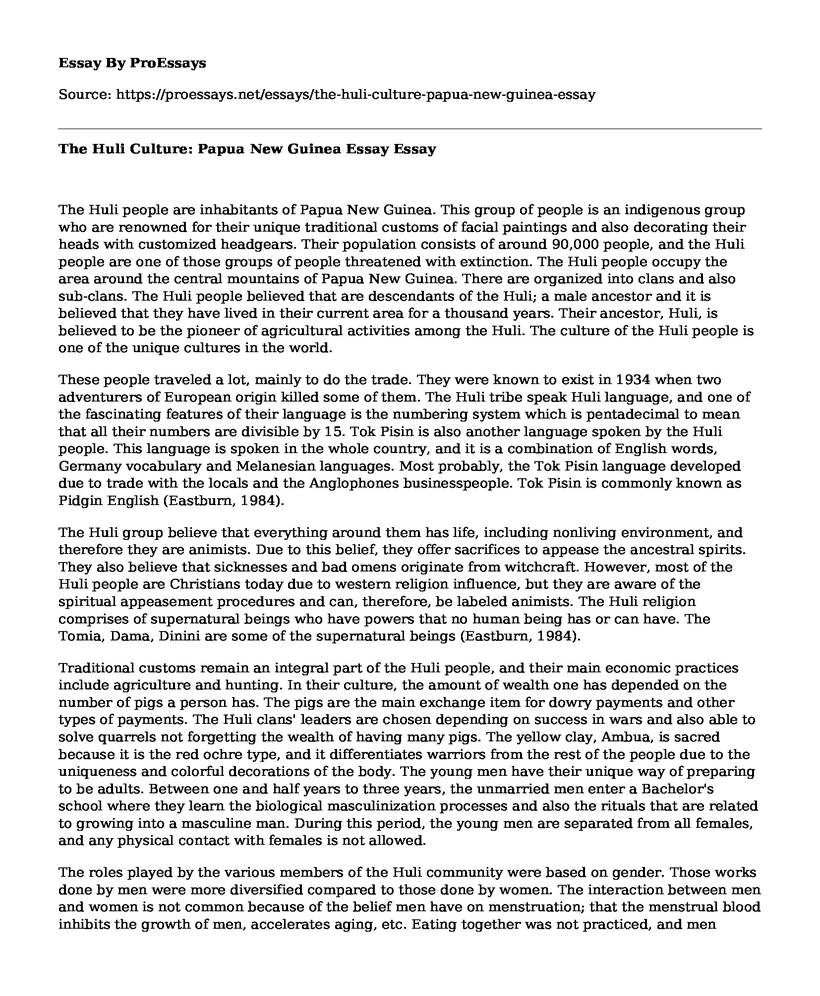The Huli people are inhabitants of Papua New Guinea. This group of people is an indigenous group who are renowned for their unique traditional customs of facial paintings and also decorating their heads with customized headgears. Their population consists of around 90,000 people, and the Huli people are one of those groups of people threatened with extinction. The Huli people occupy the area around the central mountains of Papua New Guinea. There are organized into clans and also sub-clans. The Huli people believed that are descendants of the Huli; a male ancestor and it is believed that they have lived in their current area for a thousand years. Their ancestor, Huli, is believed to be the pioneer of agricultural activities among the Huli. The culture of the Huli people is one of the unique cultures in the world.
These people traveled a lot, mainly to do the trade. They were known to exist in 1934 when two adventurers of European origin killed some of them. The Huli tribe speak Huli language, and one of the fascinating features of their language is the numbering system which is pentadecimal to mean that all their numbers are divisible by 15. Tok Pisin is also another language spoken by the Huli people. This language is spoken in the whole country, and it is a combination of English words, Germany vocabulary and Melanesian languages. Most probably, the Tok Pisin language developed due to trade with the locals and the Anglophones businesspeople. Tok Pisin is commonly known as Pidgin English (Eastburn, 1984).
The Huli group believe that everything around them has life, including nonliving environment, and therefore they are animists. Due to this belief, they offer sacrifices to appease the ancestral spirits. They also believe that sicknesses and bad omens originate from witchcraft. However, most of the Huli people are Christians today due to western religion influence, but they are aware of the spiritual appeasement procedures and can, therefore, be labeled animists. The Huli religion comprises of supernatural beings who have powers that no human being has or can have. The Tomia, Dama, Dinini are some of the supernatural beings (Eastburn, 1984).
Traditional customs remain an integral part of the Huli people, and their main economic practices include agriculture and hunting. In their culture, the amount of wealth one has depended on the number of pigs a person has. The pigs are the main exchange item for dowry payments and other types of payments. The Huli clans' leaders are chosen depending on success in wars and also able to solve quarrels not forgetting the wealth of having many pigs. The yellow clay, Ambua, is sacred because it is the red ochre type, and it differentiates warriors from the rest of the people due to the uniqueness and colorful decorations of the body. The young men have their unique way of preparing to be adults. Between one and half years to three years, the unmarried men enter a Bachelor's school where they learn the biological masculinization processes and also the rituals that are related to growing into a masculine man. During this period, the young men are separated from all females, and any physical contact with females is not allowed.
The roles played by the various members of the Huli community were based on gender. Those works done by men were more diversified compared to those done by women. The interaction between men and women is not common because of the belief men have on menstruation; that the menstrual blood inhibits the growth of men, accelerates aging, etc. Eating together was not practiced, and men would not eat food cooked by women. Men were grouped into different group each specialized in certain work (Eastburn, 1984).
Conclusion
In conclusion, the Huli culture remains one of the unique cultures in the world, and hence there is need to put measures to protect the culture from extinction. This culture is integral in defining the world heritage.
Reference
Eastburn, D. R. (1984). The Huli: People of Papua New Guinea. Boroko, P.N.G: National Cultural Council.
Cite this page
The Huli Culture: Papua New Guinea Essay. (2022, May 17). Retrieved from https://proessays.net/essays/the-huli-culture-papua-new-guinea-essay
If you are the original author of this essay and no longer wish to have it published on the ProEssays website, please click below to request its removal:
- Importance of Recognizing Cultural Differences Essay
- Impact of Alzheimer Disease on Family Patients Paper Example
- Essay on Everyday Use and Glass Menagerie: Family Struggles and Complexities
- Essay Sample on National Museum of China: Revolution & History in Beijing
- Essay Sample on Native Americans & Europeans: Conflict, Trade & Geography
- Essay on Rebellion: Refusing Authority, Influencing Behaviour and Breaking Family Norms
- Essay Example on Metis: Identity, Ancestry & Heritage







